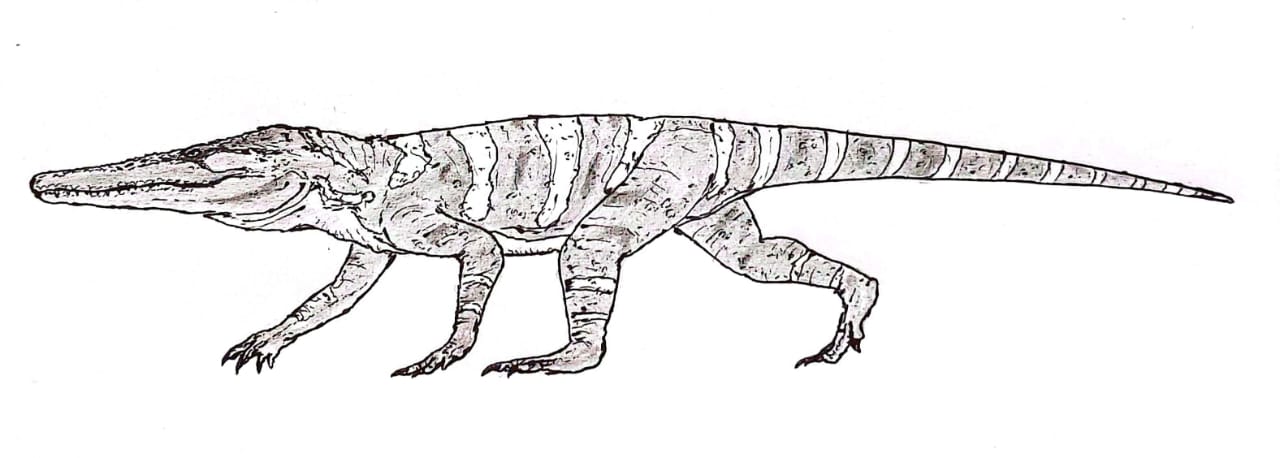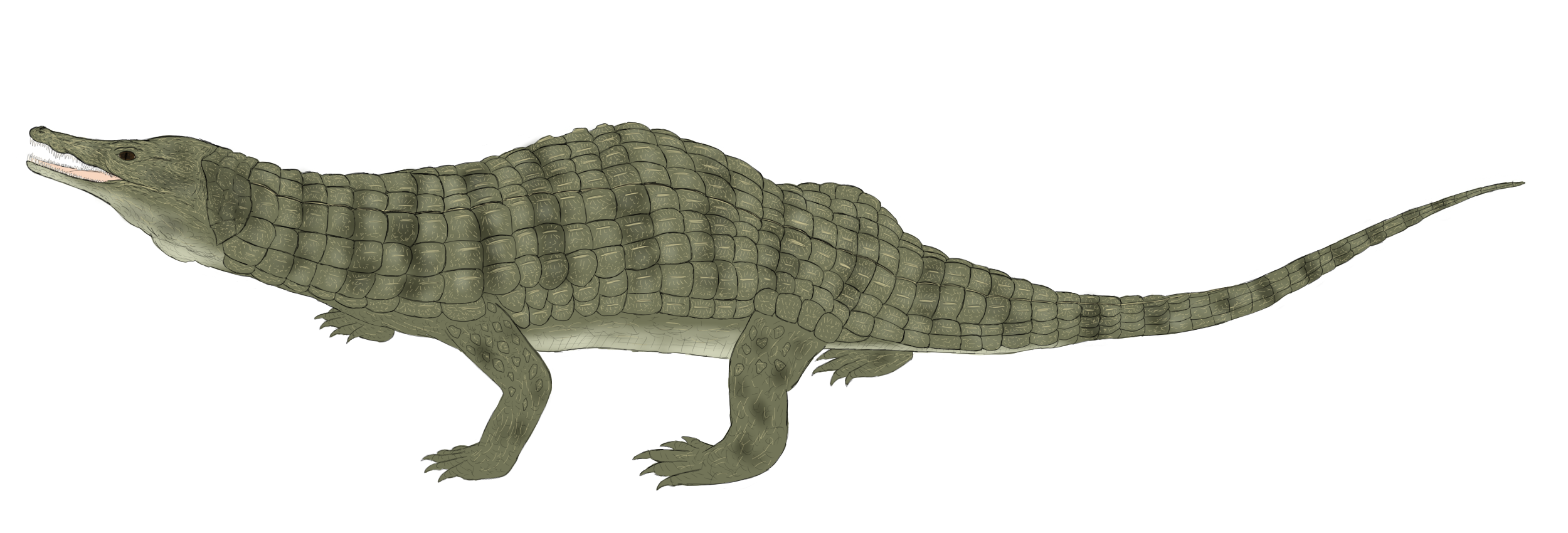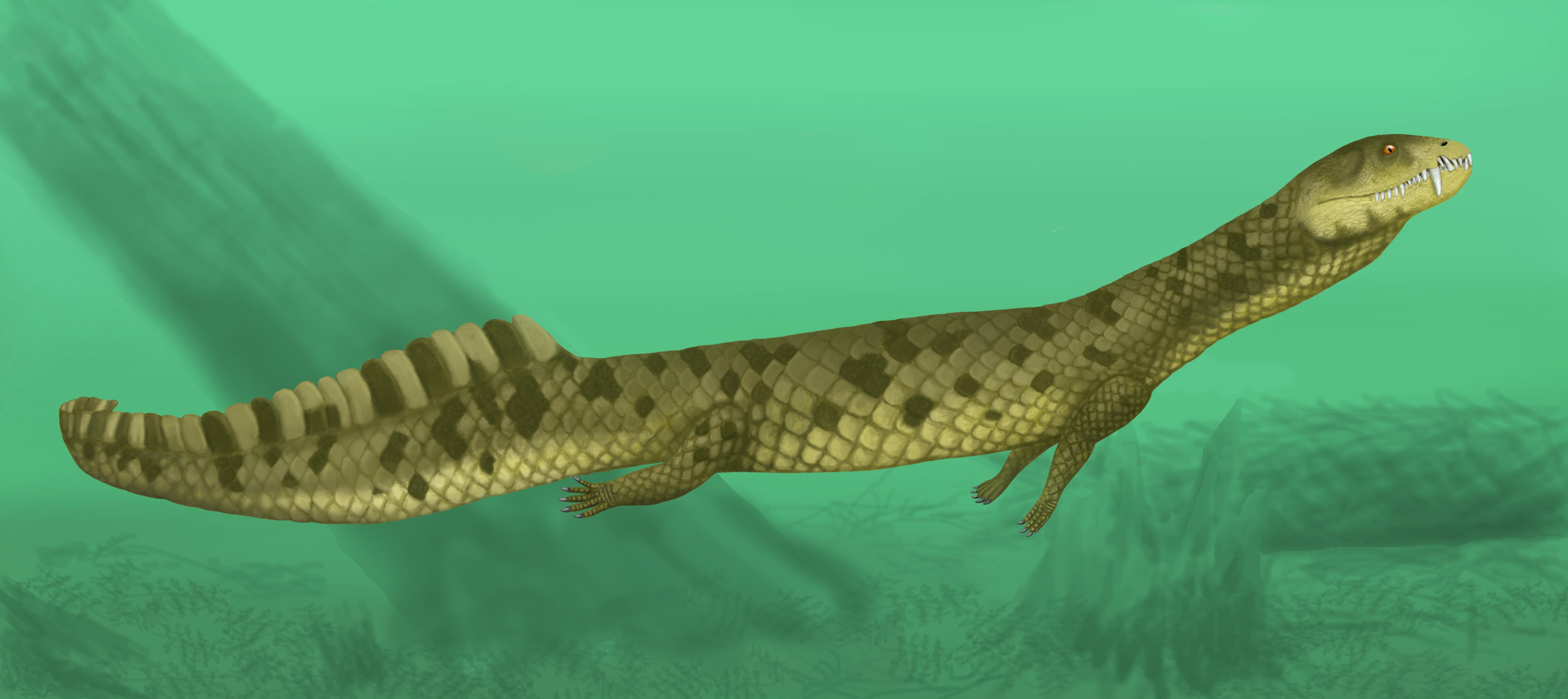Proterochampsia on:
[Wikipedia]
[Google]
[Amazon]
 Proterochampsia is a
Proterochampsia is a
/ref>
 One of the earliest phylogenies of proterochampsians was proposed by Kischlat and Schultz (1999). They considered Proterochampsia as a substitute name for Proterochampsidae, and recovered a monophyletic Rhadinosuchidae within this clade. However, more recent studies regard Proterochampsidae as the appropriate name for this clade (since no doswelliids were included), and use Rhadinosuchinae instead, as it is an internal clade of the family.
Dilkes and Arcucci (2012) combined data from several phylogenetic analyses of the Archosauriformes, such as Dilkes and Sues (2009), Ezcurra ''et al.'' (2010) and Nesbitt (2011), and added ten new characters to their matrix. The monophyly of Proterochampsia, which was restricted to proterochampsids, was supported by 12 unambiguous
One of the earliest phylogenies of proterochampsians was proposed by Kischlat and Schultz (1999). They considered Proterochampsia as a substitute name for Proterochampsidae, and recovered a monophyletic Rhadinosuchidae within this clade. However, more recent studies regard Proterochampsidae as the appropriate name for this clade (since no doswelliids were included), and use Rhadinosuchinae instead, as it is an internal clade of the family.
Dilkes and Arcucci (2012) combined data from several phylogenetic analyses of the Archosauriformes, such as Dilkes and Sues (2009), Ezcurra ''et al.'' (2010) and Nesbitt (2011), and added ten new characters to their matrix. The monophyly of Proterochampsia, which was restricted to proterochampsids, was supported by 12 unambiguous  Trotteyn and Haro (2012) conducted a phylogenetic analysis of proterochampsians and other basal archosauriforms using only braincase characters, and found '' Doswellia'', an unusual long-necked, heavily armored archosauriform from Virginia, to nest within Proterochampsia. A close relationship between ''Doswellia'' and proterochampsids was also found by Benton and Clark (1988) and Dilkes and Sues (2009). Trotteyn and Haro (2012) considered Proterochampsia to include proterochampsids and ''Doswellia'', and proterochampsids to include all proterochampsians more closely related to ''Proterochampsa'' than to ''Doswellia''. Ezcurra (2016) combined data several sets, including Nesbitt (2011) and Trotteyn and Haro (2012), and recovered a highly diverse Proterochampsia, which includes a deep split between doswelliids, including forms with aquatic adaptations, and proterochampsids. Proterochampsia was found to be the
Trotteyn and Haro (2012) conducted a phylogenetic analysis of proterochampsians and other basal archosauriforms using only braincase characters, and found '' Doswellia'', an unusual long-necked, heavily armored archosauriform from Virginia, to nest within Proterochampsia. A close relationship between ''Doswellia'' and proterochampsids was also found by Benton and Clark (1988) and Dilkes and Sues (2009). Trotteyn and Haro (2012) considered Proterochampsia to include proterochampsids and ''Doswellia'', and proterochampsids to include all proterochampsians more closely related to ''Proterochampsa'' than to ''Doswellia''. Ezcurra (2016) combined data several sets, including Nesbitt (2011) and Trotteyn and Haro (2012), and recovered a highly diverse Proterochampsia, which includes a deep split between doswelliids, including forms with aquatic adaptations, and proterochampsids. Proterochampsia was found to be the
 Proterochampsia is a
Proterochampsia is a clade
In biology, a clade (), also known as a Monophyly, monophyletic group or natural group, is a group of organisms that is composed of a common ancestor and all of its descendants. Clades are the fundamental unit of cladistics, a modern approach t ...
of early archosauriform reptile
Reptiles, as commonly defined, are a group of tetrapods with an ectothermic metabolism and Amniotic egg, amniotic development. Living traditional reptiles comprise four Order (biology), orders: Testudines, Crocodilia, Squamata, and Rhynchocepha ...
s from the Triassic
The Triassic ( ; sometimes symbolized 🝈) is a geologic period and system which spans 50.5 million years from the end of the Permian Period 251.902 million years ago ( Mya), to the beginning of the Jurassic Period 201.4 Mya. The Triassic is t ...
period. It includes the Proterochampsidae (e.g. '' Proterochampsa'', '' Chanaresuchus'' and '' Tropidosuchus'') and probably also the Doswelliidae. Nesbitt (2011) defines Proterochampsia as a stem-based taxon
Phylogenetic nomenclature is a method of nomenclature for taxon, taxa in biology that uses phylogenetics, phylogenetic definitions for taxon names as explained below. This contrasts with Biological classification, the traditional method, by which ...
that includes '' Proterochampsa barrionuevoi'' and all forms more closely related to it than '' Euparkeria capensis'', ''Erythrosuchus africanus
''Erythrosuchus'' (from , 'red' and , 'crocodile') is an extinct genus of archosauriform reptiles from the early Triassic of South Africa. Remains have been found from the Cynognathus Assemblage Zone of the Beaufort Group in the Karoo of South ...
'', '' Passer domesticus'' (the House Sparrow), or ''Crocodylus niloticus
The Nile crocodile (''Crocodylus niloticus'') is a large crocodilian native to freshwater habitats in Africa, where it is present in 26 countries. It is widely distributed in sub-Saharan Africa, occurring mostly in the eastern, southern, and ce ...
'' (the Nile crocodile). Therefore, the inclusion of Doswelliidae in it is dependent upon whether '' Doswellia'' and '' Proterochampsa'' form a monophyletic
In biological cladistics for the classification of organisms, monophyly is the condition of a taxonomic grouping being a clade – that is, a grouping of organisms which meets these criteria:
# the grouping contains its own most recent co ...
group to the exclusion of Archosauria and other related groups.
Description
Nesbitt (2011) found that Proterochampsians share several distinguishing characteristics, orsynapomorphies
In phylogenetics, an apomorphy (or derived trait) is a novel character or character state that has evolved from its ancestral form (or plesiomorphy). A synapomorphy is an apomorphy shared by two or more taxa and is therefore hypothesized to ...
. A prominent ridge runs along the length of the jugal, a bone below the eye. Another ridge is present on the quadratojugal, a bone positioned toward the back of the skull behind the jugal. There is also a depression on the squamosal bone of the skull roof
The skull roof or the roofing bones of the skull are a set of bones covering the brain, eyes and nostrils in bony fishes, including land-living vertebrates. The bones are derived from dermal bone and are part of the dermatocranium.
In com ...
. The second metatarsal
The metatarsal bones or metatarsus (: metatarsi) are a group of five long bones in the midfoot, located between the tarsal bones (which form the heel and the ankle) and the phalanges ( toes). Lacking individual names, the metatarsal bones are ...
of the foot is wider than the other metatarsals. Proterochampsians lack a fifth digit on the foot; the fifth metatarsal is reduced to a small pointed bone. However, Nesbitt (2011) only considered Proterochampsia to include Proterochampsidae. Ezcurra (2016), who recovered a clade formed by Proterochampsidae and Doswelliidae, defined Proterochampsia by up-facing nostrils, maxilla
In vertebrates, the maxilla (: maxillae ) is the upper fixed (not fixed in Neopterygii) bone of the jaw formed from the fusion of two maxillary bones. In humans, the upper jaw includes the hard palate in the front of the mouth. The two maxil ...
-to- prefrontal contact, the tooth bearing part of the upper jaw being curved downwards, neck and front back vertebrae
Each vertebra (: vertebrae) is an irregular bone with a complex structure composed of bone and some hyaline cartilage, that make up the vertebral column or spine, of vertebrates. The proportions of the vertebrae differ according to their spinal ...
lacking a postzygodiapophyseal lamina, tibia with straight cnemial crest, fifth metatarsal that is not hook-shaped in its inner end, well developed foot phalanges
The phalanges (: phalanx ) are digit (anatomy), digital bones in the hands and foot, feet of most vertebrates. In primates, the Thumb, thumbs and Hallux, big toes have two phalanges while the other Digit (anatomy), digits have three phalanges. ...
on the fifth digit but with a poorly developed first phalanx, among other traits.Ezcurra MD. (2016) The phylogenetic relationships of basal archosauromorphs, with an emphasis on the systematics of proterosuchian archosauriforms. ''PeerJ'', 4:e177/ref>
Phylogeny
 One of the earliest phylogenies of proterochampsians was proposed by Kischlat and Schultz (1999). They considered Proterochampsia as a substitute name for Proterochampsidae, and recovered a monophyletic Rhadinosuchidae within this clade. However, more recent studies regard Proterochampsidae as the appropriate name for this clade (since no doswelliids were included), and use Rhadinosuchinae instead, as it is an internal clade of the family.
Dilkes and Arcucci (2012) combined data from several phylogenetic analyses of the Archosauriformes, such as Dilkes and Sues (2009), Ezcurra ''et al.'' (2010) and Nesbitt (2011), and added ten new characters to their matrix. The monophyly of Proterochampsia, which was restricted to proterochampsids, was supported by 12 unambiguous
One of the earliest phylogenies of proterochampsians was proposed by Kischlat and Schultz (1999). They considered Proterochampsia as a substitute name for Proterochampsidae, and recovered a monophyletic Rhadinosuchidae within this clade. However, more recent studies regard Proterochampsidae as the appropriate name for this clade (since no doswelliids were included), and use Rhadinosuchinae instead, as it is an internal clade of the family.
Dilkes and Arcucci (2012) combined data from several phylogenetic analyses of the Archosauriformes, such as Dilkes and Sues (2009), Ezcurra ''et al.'' (2010) and Nesbitt (2011), and added ten new characters to their matrix. The monophyly of Proterochampsia, which was restricted to proterochampsids, was supported by 12 unambiguous synapomorphies
In phylogenetics, an apomorphy (or derived trait) is a novel character or character state that has evolved from its ancestral form (or plesiomorphy). A synapomorphy is an apomorphy shared by two or more taxa and is therefore hypothesized to ...
in their analysis, including the presence of dermal sculpturing on skull that consists of prominent ridges or tubercles on frontals, parietals and nasals; a contact between the maxilla and the prefrontal, separating lacrimal and nasal; a strongly convex dorsal margin of surangular and palatal teeth that are inserted into alveoli. Some of the synapomorphies recovered by Nesbitt (2011) were found to support either the node ''Cerritosaurus'' + ''Chanaresuchus'' or the node ''Tropidosuchus'' + ''Chanaresuchus''.
 Trotteyn and Haro (2012) conducted a phylogenetic analysis of proterochampsians and other basal archosauriforms using only braincase characters, and found '' Doswellia'', an unusual long-necked, heavily armored archosauriform from Virginia, to nest within Proterochampsia. A close relationship between ''Doswellia'' and proterochampsids was also found by Benton and Clark (1988) and Dilkes and Sues (2009). Trotteyn and Haro (2012) considered Proterochampsia to include proterochampsids and ''Doswellia'', and proterochampsids to include all proterochampsians more closely related to ''Proterochampsa'' than to ''Doswellia''. Ezcurra (2016) combined data several sets, including Nesbitt (2011) and Trotteyn and Haro (2012), and recovered a highly diverse Proterochampsia, which includes a deep split between doswelliids, including forms with aquatic adaptations, and proterochampsids. Proterochampsia was found to be the
Trotteyn and Haro (2012) conducted a phylogenetic analysis of proterochampsians and other basal archosauriforms using only braincase characters, and found '' Doswellia'', an unusual long-necked, heavily armored archosauriform from Virginia, to nest within Proterochampsia. A close relationship between ''Doswellia'' and proterochampsids was also found by Benton and Clark (1988) and Dilkes and Sues (2009). Trotteyn and Haro (2012) considered Proterochampsia to include proterochampsids and ''Doswellia'', and proterochampsids to include all proterochampsians more closely related to ''Proterochampsa'' than to ''Doswellia''. Ezcurra (2016) combined data several sets, including Nesbitt (2011) and Trotteyn and Haro (2012), and recovered a highly diverse Proterochampsia, which includes a deep split between doswelliids, including forms with aquatic adaptations, and proterochampsids. Proterochampsia was found to be the sister taxon
In phylogenetics, a sister group or sister taxon, also called an adelphotaxon, comprises the closest relative(s) of another given unit in an evolutionary tree.
Definition
The expression is most easily illustrated by a cladogram:
Taxon A and ...
of Archosauria, whose living representatives consist of bird
Birds are a group of warm-blooded vertebrates constituting the class (biology), class Aves (), characterised by feathers, toothless beaked jaws, the Oviparity, laying of Eggshell, hard-shelled eggs, a high Metabolism, metabolic rate, a fou ...
s and crocodilian
Crocodilia () is an Order (biology), order of semiaquatic, predatory reptiles that are known as crocodilians. They first appeared during the Late Cretaceous and are the closest living relatives of birds. Crocodilians are a type of crocodylomorp ...
s. Multiple updated versions of the analysis performed by Ezcurra have been published, including the analysis of Paes-Neto and colleagues in their 2023 description of two new genera of proterochampsids, '' Kuruxuchampsa'' and '' Pinheirochampsa''.
References
{{Taxonbar, from=Q2918578 Triassic reptiles of South America Ladinian first appearances Norian extinctions Taxa named by José Bonaparte